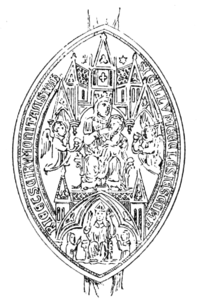Tavistock Abbey

Tavistock Abbey, also known as the Abbey of
History

Foundation
Older historians thought the abbey was founded in 961 by
Account by Dugdale
William Dugdale's Monasticon Anglicanum (1718 edition in English) states as follows concerning the foundation:[4]
In the reign of King Edgar an Earl call'd Ordulphus had a vision commanding him to build an oratory in a certain place mark'd out to him, which he did, making it large enough to contain 1,000 persons, and erecting habitations for several monks, whom he also plac'd there under an abbat. The lands he and his kindred and friends gave to this monastery were: Tavistock, Midleton, Hatherlege (Hatherleigh), Berliton, Leghe, Dunethem, Chuvelin, Lankinghorn, Home, Werelgete, Orlege (Orleigh), Auri (Annery), Rame, Savyock, Pannastan, Tomebiry, Colbrok, Lege, Wulsitheton, and Clymesland. These never to be alienated and to be free from all impositions, except an expedition undertaken and the repairing of forts and bridges. This was confirmed in the year 981 and in the reign of King Ethelred...The Bull of Pope Celestin dated 1193 confirms all donations made to these monks...
1193 papal bull
A "Bull of Exemption and Confirmation" dated 1193 granted by Pope Celestine III (reigned 1191–1198) records the landholdings of the abbey thus:[5]
- Middelton (Milton Abbot, in Lifton, later Tavistock, hundred)
- Hatherlega (Hatherleigh)
- Boryngton (Burrington, a manor in North Tawton hundred)
- Lega (Romansleigh)
- Abbedesham (Abbotsham)
- Weredeget (Worthygate, Parkham)
- Ordlegh (Orleigh)
- Auri (Annery)
- Tornebury (Thornbury, a manor in Black Torrington hundred)
- Rauburga/Roughburgh (Roborough, near Tavistock)
- One house in the City of Exeter
- Wella (Coffinswell, a manor in Haytor hundred)
- Daggecumba (Daccombe, within Coffinswell)
- Plymstok (Plymstock)
- Raddon (Raddon, Thorverton)
- Hundetorre (Hound Tor, Manaton)
- Odatrew (Ottery, in Lamerton)
Later abbots
Abbot Lyfing and his successor Abbot
Dissolution
On 3 March 1539 the last abbot, John Peryn, together with twenty monks, surrendered the abbey to the king
Saint Rumon
St Rumon was probably a brother of St
Cornwall
The abbey had considerable land holdings in Cornwall and three churches there are dedicated to St Rumon:
In early times the Isles of Scilly were in the possession of a confederacy of hermits. King Henry I gave the hermits' territory to the abbey of Tavistock, which established a priory on Tresco that was abolished at the Reformation.[15]
Burials
- Lyfing of Winchester
- Ordgar, Ealdorman of Devon
- Eadwig Ætheling
- Ordwulf
Hurdwick quarry
The monks owned nearby Hurdwick quarry, the stone from which is notable for its greenish colour. Tavistock is built, in large parts, of this material. On close inspection, the stone appears to have a pitted surface that can be confused with decay.[16]
See also
- Abbot of Tavistock
- Dartmoor crosses
- Morwellham Quay – was established by the monks
- List of monastic houses in Devon
- List of monastic houses in England
References
- ^ a b c d Chisholm, Hugh, ed. (1911). . Encyclopædia Britannica. Vol. 26 (11th ed.). Cambridge University Press. pp. 457–458.
- ^ "Tavistock Abbey". Historic England. 28 August 2001. Retrieved 23 September 2020.
- ISBN 978-0-903766-02-9.
- ^ Dugdale, William, Monasticon Anglicanum, 1718 edition, pp.115-16, "Additions made to the Benedictines" (i.e. addenda to his original work)[1].
- ^ Thorn, Caroline & Frank, (eds.) Domesday Book, (Morris, John, gen.ed.) Vol. 9, Devon, Parts 1 & 2, Phillimore Press, Chichester, 1985, Part 2 (notes), chapter 5.
- ^ A mitred abbot could sit in Parliament among the Lords and probably had the title Abbot-Sovereign.
- ^ Richard Banham (1492 - 1523), the 39th Abbot, was more likely to have been Richard Baynham who was granted arms in the time of Henry VIII as follows: Gules a mace in bend sinister surmounted by a pastoral staff in bend dexter or on a chief argent three pierced mullets of five points sable (College of Arms Ms: 2G4/5b). Richard Baynham has been referred to as Richard Banham in a number of places. He was created Baron Hurdwick in 1514 (another name for the Hundred of Tavistock) (Richard Nicholls Worth A History of Devonshire:With Sketches of it Leading Worthies). See also - Oliver, George (1820) Historic Collections Relating to the Monasteries in Devon. Exeter: printed by R. Cullum.
- ^ "MDV3919 Tavistock Abbey". Devon & Dartmoor HER. Heritage Gateway. 29 October 2019. Retrieved 23 September 2020.
- ^ Holdsworth, Christopher (1999). "Ecclesiastical Institutions". In Kain, R.; Ravenhill W. (eds.). Historical Atlas of South West England. Exeter. p. 210.
{{cite book}}: CS1 maint: location missing publisher (link) - ^ Debrett's Peerage, 1968, p.132.
- ^ Pevsner, N., Buildings of England: Devon, 1991, p.354.
- ^ "Relative Values: Olga Polizzi and her daughter Alexandra". Times Newspapers Limited. London: TimesOnline.co.uk. 6 July 2008. Retrieved 29 August 2009.
- ^ "Keltic Kalendar", in Cornish Church Guide. Truro: Blackford; pp. 9-16.
- ^ Thorn, C. et al. (eds.) (1979) Cornwall. Chichester: Phillimore; entries 3,1-7.
- ^ Cornish Church Guide; p. 194.
- ISBN 9780300095968
Bibliography
- Herbermann, Charles, ed. (1913). . Catholic Encyclopedia. New York: Robert Appleton Company.
- This article incorporates text from a publication now in the public domain: Chisholm, Hugh, ed. (1911). "Tavistock". Encyclopædia Britannica. Vol. 26 (11th ed.). Cambridge University Press. pp. 457–458.
 This article incorporates text from a publication now in the public domain: Herbermann, Charles, ed. (1913). "Tavistock Abbey". Catholic Encyclopedia. New York: Robert Appleton Company.
This article incorporates text from a publication now in the public domain: Herbermann, Charles, ed. (1913). "Tavistock Abbey". Catholic Encyclopedia. New York: Robert Appleton Company.
Further reading
- Victoria County History: Devonshire;
- Doble, Gilbert H. (1939) Saint Rumon and Saint Ronan; with notes on the parishes of Ruan Lanihorne, Ruan Major, and Ruan Minor by Charles Henderson. Long Compton : King's Stone Press
- Kempe, A. J. (1830) Notices of Tavistock and its Abbey; from the "Gentleman's Magazine" for 1830. London: J. B. Nichols (only 20 copies printed)

